Fomitopsis pinicola (Sw.) P. Karst. - Red-belted Bracket
Phylum: Basidiomycota - Class: Agaricomycetes - Order: Polyporales - Family: Fomitopsidaceae
Distribution - Taxonomic History - Etymology - Identification - Culinary Notes - Reference Sources
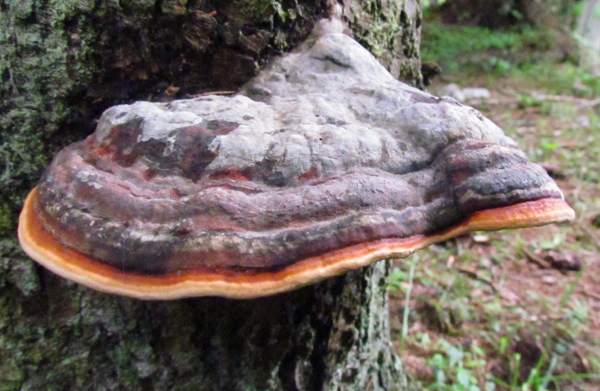
An orange or red band is nearly always present between the older annual layers and the current layer, making this polypore instantly recognisable.
Distribution
Rare in Britain and Ireland but common in most countries of mainland Europe, in Scandinavia Fomitopsis pinicola is very common, and in Slovenia the Red-belted Bracket is quite often seen the trunks of aged birches and Beech trees as well as on conifers.
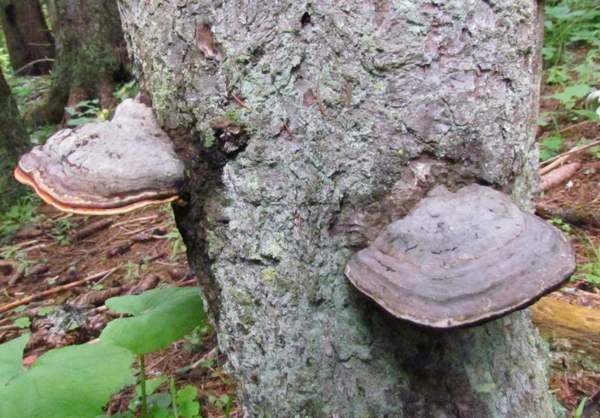
In old fruitbodies (right-hand bracket in the picture on the left), the red belt is not always clearly visible, and then it is easy to mistake Fomitopsis pinicola for the Hoof Fungus Fomes fomentarius.
Taxonomic history
The Red-belted Bracket was first described scientifically in 1810 by (NB: we assume but as yet have no reference source for confrmation) Swedish botanist Olof Swartz (1760 - 1818), who gave it the binomial scientific name Boletus pinicola. In 1881 the Finnish mycologist Petter Adolf Karsten (1834 - 1917) transferred this species to the new genus Fomitopsis, which he set up at that time, thus establishing the Red-belted Bracket's currently-accepted scientific name Fomitopsis pinicola.
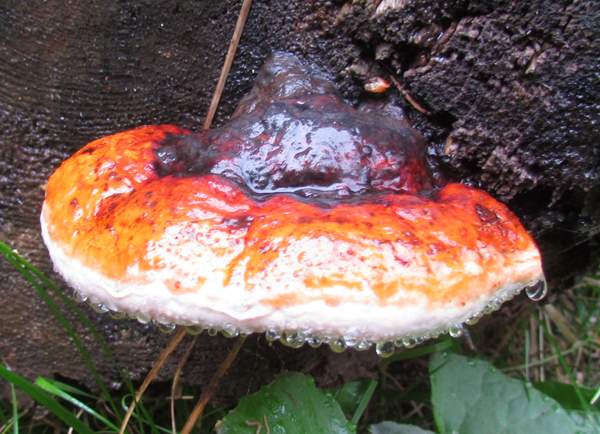
Synonyms of Fomitopsis pinicola include Boletus pinicola Sw., and Polyporus pinicola (Sw.) Fr.
Fomitopsis pinicola is the type species of the genus Fomitopsis.
Etymology
Fomitopsis, the generic name, means 'similar in appearance to Fomes' (the latter being genus containing Fomes fomentarius, the Hoof Fungus, with which the Red-belted Bracket is sometimes confused. The specific epithet pinicola means inhabiting (living on) Pinus species, in other words pine trees.
The pores and the margins of young fruitbodies sometimes exude watery droplets - an example can be seen in the picture on the left, where a young bracket is growing on the cut surface of a felled pine tree.
Identification guide
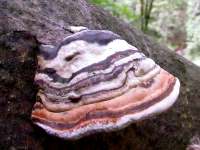 |
Upper (infertile) surfaceAnnual layers of tubes build up to produce a large brackets, usually in the form of a woody hoof-shaped structure 8 to 25cm across and typically 5 to 10cm deep at the centre of the attachment area. The upper infertile surface, appearing as though varnished in young brackets but gradually dulling with age, is mainly grey with annual zone rings and ridges, but there is nearly always an orange or red growing band near the rim and a thinner white band right at the outermost edge. |
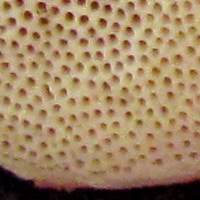 |
Pores and TubesInside the fruiting body the flesh is hard and pale brown, while the spore-bearing surface has minute roundish pores, spaced at 3 to 4 per mm; the pores are cream at first (and bruise yellowish buff) but with age they become brown.
|
SporesEllipsoidal to cylindrical, smooth, 6-8 x 3.5-4μm; inamyloid. Spore printVery pale lemon yellow. |
|
Odour/taste |
Not significant. |
Habitat & Ecological role |
This pale-spored perennial polypore is found on living or dead conifers and occasionally on birches. |
Season |
Brackets can be seen all year round, but these perennial fungi shed their spores in late summer and autumn. They can live for several years, and if you cut through a bracket it is easy to count the number of tube layers and hence the age of the fruitbody. |
Similar species |
This perennial bracket could be confused with Hoof Fungus, Fomes fomentarius, which is also hoof-shaped and has a grey upper surface but lacks the red or orange banding. |
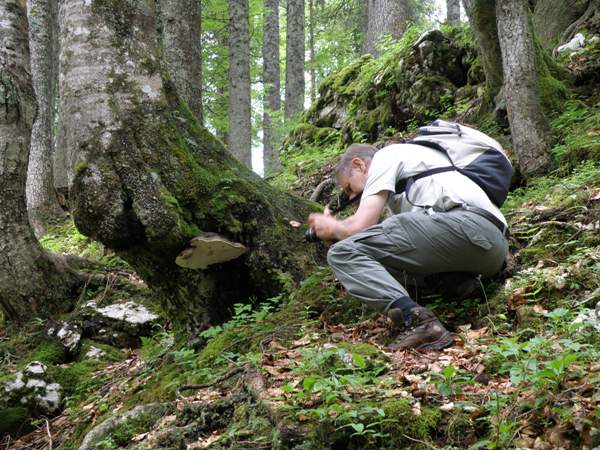
Culinary Notes
These bracket fungi are far too tough to be edible.
Reference Sources
Mattheck, C., and Weber, K. Manual of Wood Decays in Trees. Arboricultural Association 2003.
Pat O'Reilly, Fascinated by Fungi, 2016.
Dictionary of the Fungi; Paul M. Kirk, Paul F. Cannon, David W. Minter and J. A. Stalpers; CABI, 2008
Taxonomic history and synonym information on these pages is drawn from many sources but in particular from the British Mycological Society's GB Checklist of Fungi.
Fascinated by Fungi. Back by popular demand, Pat O'Reilly's best-selling 450-page hardback book is available now. The latest second edition was republished with a sparkling new cover design in September 2022 by Coch-y-Bonddu Books. Full details and copies are available from the publisher's online bookshop...

